The City of Marvelous Disorder is a study was conducted during the ‘CaaS studio (City as a Service): The future of cities’ services in the AI times’, that aims to built a methodology on mapping the creative sector and high education ecosystem of Barcelona, with a particular focus on social creative industry that works within the fields of culture, environment, and education to promote democratization and inclusivity of culture.
-Introducing Creativity-

Creativity is the ability to use imagination and original ideas to create something new and valuable. It can take many different forms, from artistic expression to scientific innovation to problem-solving in everyday life but also creativity can manifest itself in numerous contexts, ranging from museums, exhibitions, and libraries to academic environments and beyond. It can be literally anywhere, but specifically in cities, creativity tends to be more intricate and multifaceted, reflecting the diverse nature of these environments.

In the late 1990s and early 2000s, urban planners and policymakers began to recognize the potential of creativity and consequently of the creative industries to revitalize declining urban areas and the concept of the “creative city” began to gain traction as it implies that city’s cultural and creative resources can drive economic growth and development. Two dominant interpretations of the Creative City have emerged:
- Economically- drivel regional development (Richard Florida) emphasizes the role of the creative class and the creative economy in driving regional economic development
- Urban centered view of culture and creativity (Charles Landry) puts emphasis on the role of cultural and creative infrastructure in supporting social and cultural diversity in order to re-energize and democratize the cities.
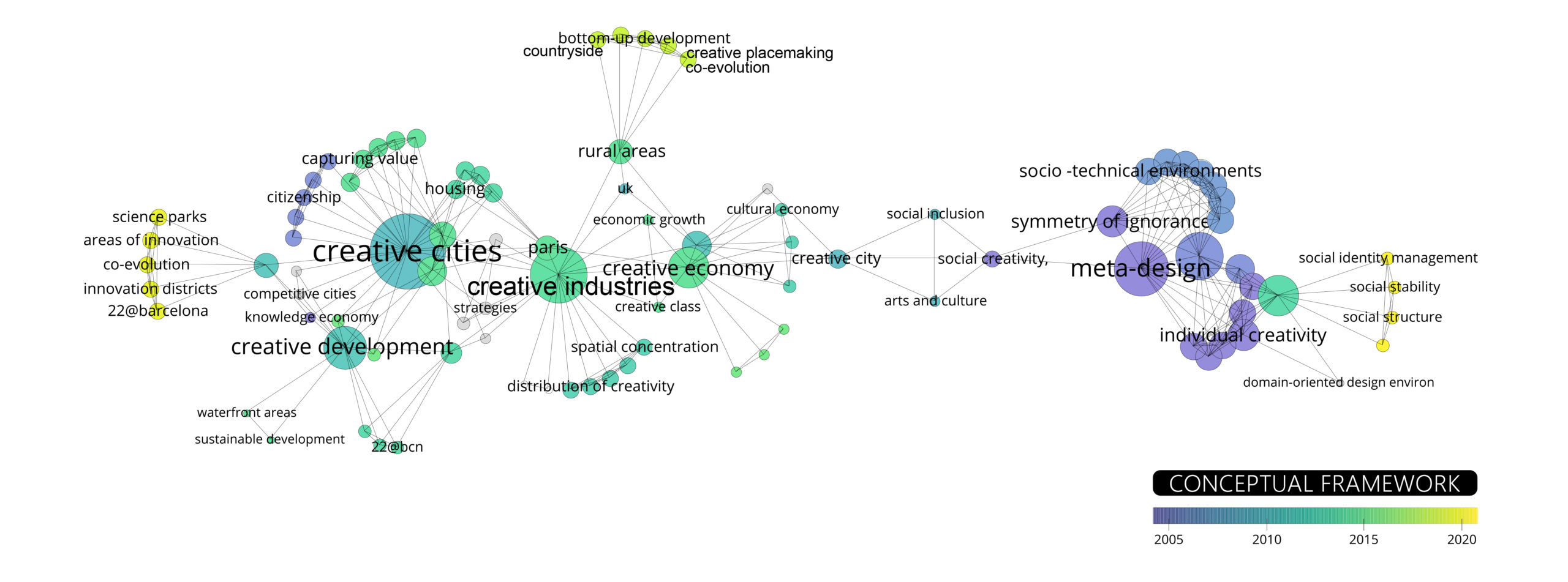
To gain a comprehensive understanding of the whole complexity of creativity in cities, and recognizing the importance of diverse perspectives, the literature review for this study has been developed throughout a network analysis out of 35 scientific papers and based on it, three highly correlated areas are identified:
- The creative development of the city with examples of innovation districts and innovative developments in waterfront and post-industrial areas such as 22@bcn.
- The potential of distributing creativity, embracing bottom-up approaches and creative placemaking initiatives.
- The processes of innovation based on social infrastructures that allow new forms of collaborative designs and community empowerment.
-Mapping the Creative Industries in Barcelona-
The methodological approach adopted in this study is composed of three main parts, starting with the analysis of the creative sector and high education, followed by the analysis of the social creativity, and culminating with a study on prospective future scenarios. Each distinct part adopts a particular approach to mapping that involves utilizing different correlations, computational tools, indicators and visualization techniques.
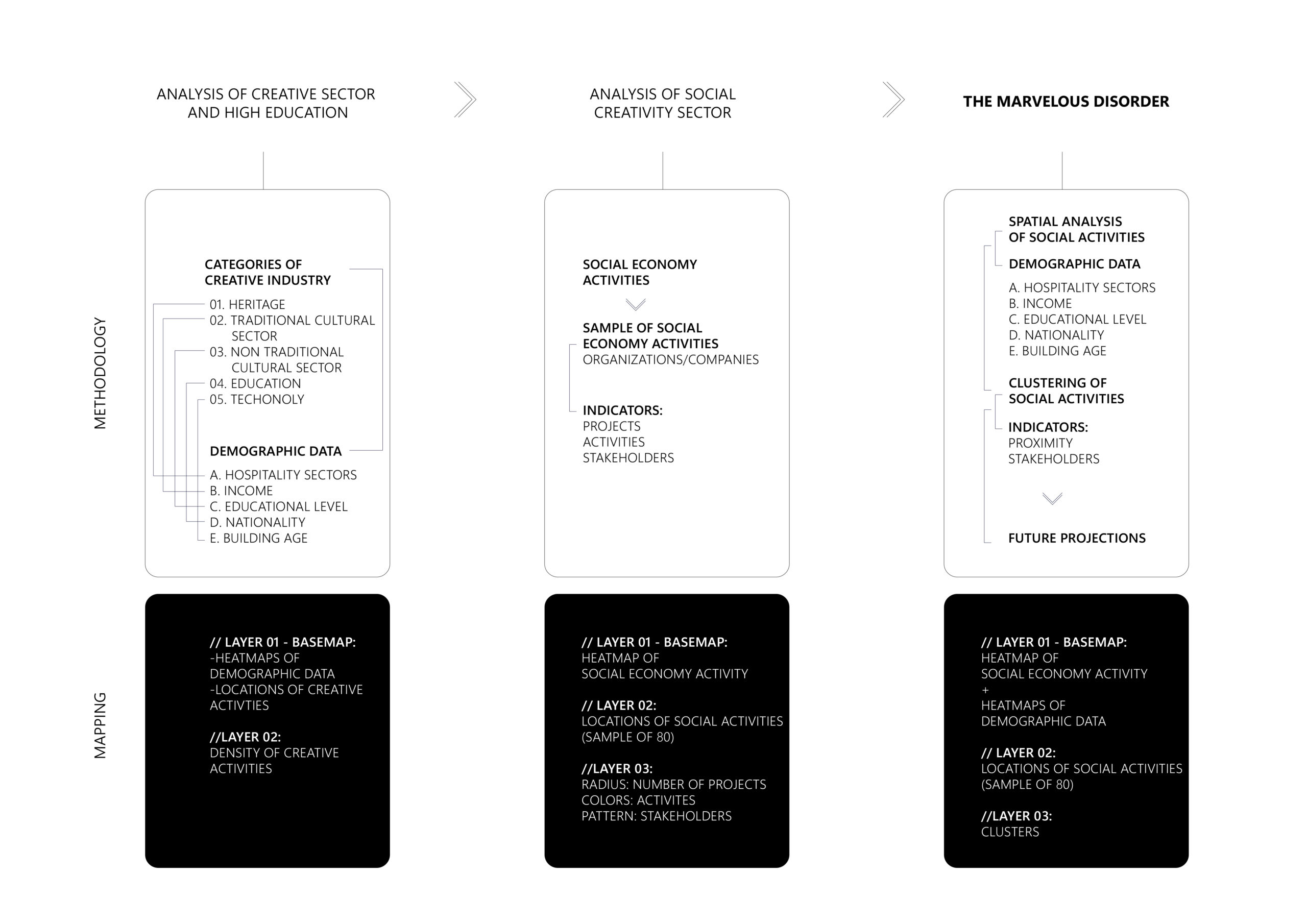
// ANALYSIS OF CREATIVE SECTOR AND HIGH EDUCATION:
Categorizing the creative industry into Heritage, Traditional and Non-Traditional Sectors, Higher Education Ecosystem, and Technological Activities, interrelating the five categories with demographic data obtained by the National Institute of Statistics (INE), the Catalan Institute of Statistics (ICE), the Spanish Cadastre, and the inAtlas company as well, this analysis part aims to provide a comprehensive picture of the creative industry across districts in Barcelona, but also to depict patterns and to reveal diversity and the underlying relationships that may exist among these categories.
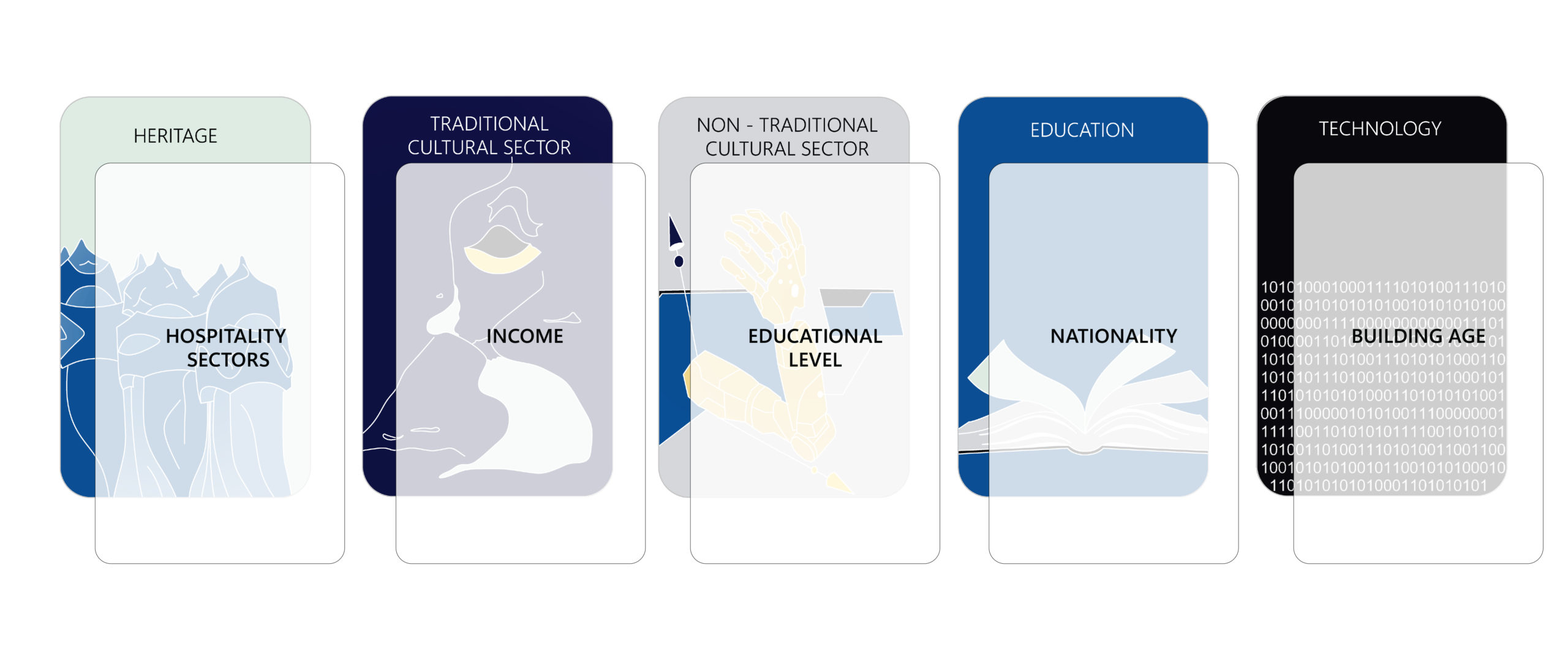
- HERITAGE / HOPSITALITY SECTOR:
-High correlation between the concentration of 2/3 of the museums offering in the city and the urban heritage as a touristic attraction.
– The City Council is implementing measures to make culture and arts more readily available to local residents by utilizing 11 upcycled industrial buildings to house cultural atheneums and creative factories - TRADITIONAL CULTURAL SECTOR / INCOME:
–FINE ARTS: While the production of fine arts is well spread across the entire city, music venues and art galleries are more heavily concentrated in central districts. This location choice may not necessarily be influenced by the income level of the area, but rather its accessibility and influx of people.
–PERFORMING ARTS are conceived as a consumption product. In Barcelona there is a positive coverage of this sector, with a concentration of main theaters, with potential high ticket prices, where wealthier individuals live.
–WRITING – PUBLISHING ACTIVITES: The frequency of writing and publishing activities is evenly distributed throughout the city, finding a slightly larger concentration in areas with mid-high income where citizens may spend more on cultural activities.
–VISUAL ARTS & MEDIA: Along Diagonal Avenue, there is a high density of the value chain activities (Production/Publishing/Distribution) following an agglomeration effect that enriches the ecosystem but also highlighting that the high income level of the area is correlated with intensive knowledge jobs required for these activities.

- NON TRADITIONAL CULTURAL SECTOR / EDUCATIONAL LEVEL:
Barcelona’s distribution of Non-Traditional cultural activities, which necessitate advanced skill sets and knowledge, is closely linked to the prevalence of highly educated citizens in the region. This association is particularly noticeable in the central districts and 22@, which are acknowledged as innovative and imaginative areas. - EDUCATION / NATIONALITY:
Barcelona possesses a well-developed educational infrastructure comprising universities, which enables it to attract a diverse and global pool of talent. Typically, young foreigners with medium-high spending power tend to cluster around the neighborhoods in close proximity to the university faculties. - TECHNOLOGY / CONSTRUCTION AGE OF URBAN FABRIC :
Tech companies in Barcelona are concentrated in two main clusters – the first one is located around the established urban fabric of Eixample, while the second one is situated in Poblenou, which is emerging as the city’s innovation district, occupying both new and repurposed industrial office buildings.
-Introducing Social Creativity–

Social creativity is a unique form of creative activity that uses innovative thinking and collaborative methods to address social issues and promote community development, distinguishing it from other creative sectors that may focus more on commercial outcomes. By leveraging the power of social creativity, cities can not only foster economic growth, but also create more inclusive urban environments.”
C. Landry (2000). “The Creative City: A Toolkit for Urban Innovators”
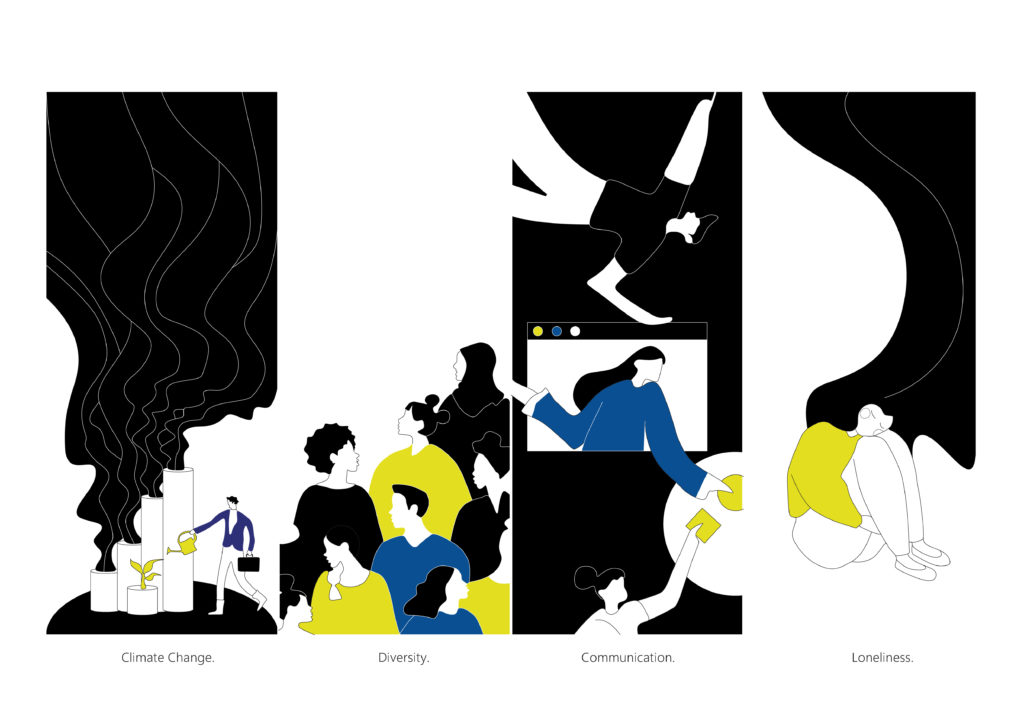
Urban space is often characterized by linear and rigid structures that restrict social dynamics, by referring to social challenges such as environmental justice, diversity, communication and loneliness, social creativity has the potential to disrupt these norms, creating opportunities for disorder and diverse forms of cultural expression.
// ANALYSIS OF SOCIAL CREATIVE SECTOR:
Mapping the social creative sector in Barcelona, is essential not only to understand the spatial distribution but also to uncover the broader framework surrounding it. To what extent is the creative industry thriving in the city? What specific areas does it encompass? Who are the key players involved in its support and development, and in what ways do they contribute?
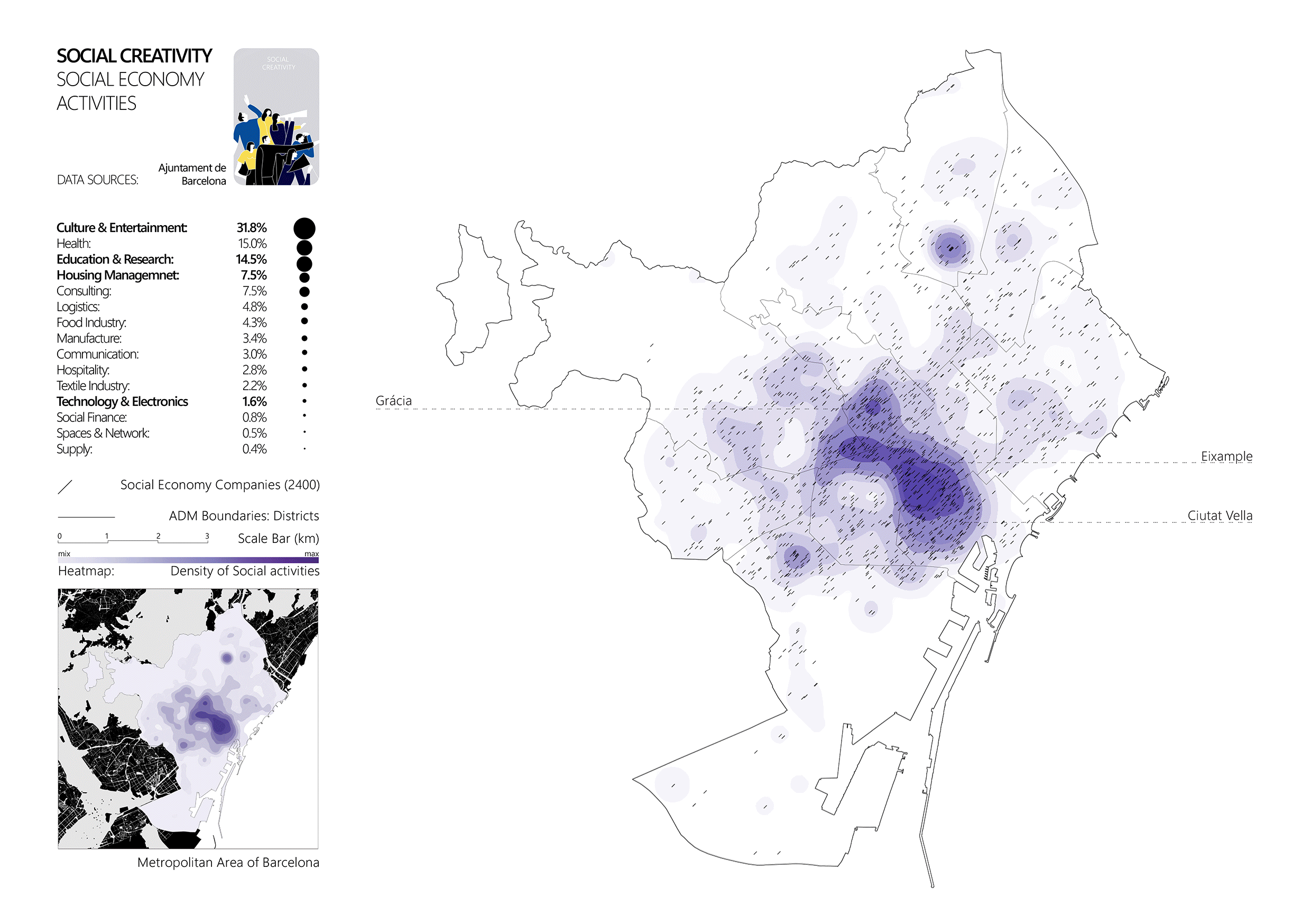
The analysis of the social creative industry consists of four highly interconnected steps:
- Mapping and analyzing the density of the Social Creative Companies and Organizations provided by the social and solidarity economy dataset of the Municipality of Barcelona that encompasses over 2,000 entities, with 32% of them being focused on culture and entertainment. It is also worth mentioning, that the dataset may not include smaller or less formal organizations that have not been registered.
- Enhancing the representativeness of our study, by collaborating with the CHAT-GPT, additional 100 small to medium size organizations and companies focusing on social creativity withing the cultural sector of Barcelona are identified, generating our own dataset afterwards.
- Selecting a sample of 80 organizations and companies form both of the datasets in order to conduct a more in-depth analysis.
- Analyzing the social creative organizations and companies based on 3 indicators: Number or Projects / Activities / Engaged Stakeholders.

The selected social organizations and companies in Barcelona exhibit diversity in terms of their activities, popularity, interaction, and initiatives. Depending on the number of projects they undertake, some organizations are more extroverted or introverted than others however they cover an array of disparate topics. Based on it, they are categorized into 13 activity codes (GCNAE) according to the National Classification of Economic Activities, highlighting that 44% of them are focused on artistic and entertainment activities while 19% of the total organizations and companies work within the field of technology and science.
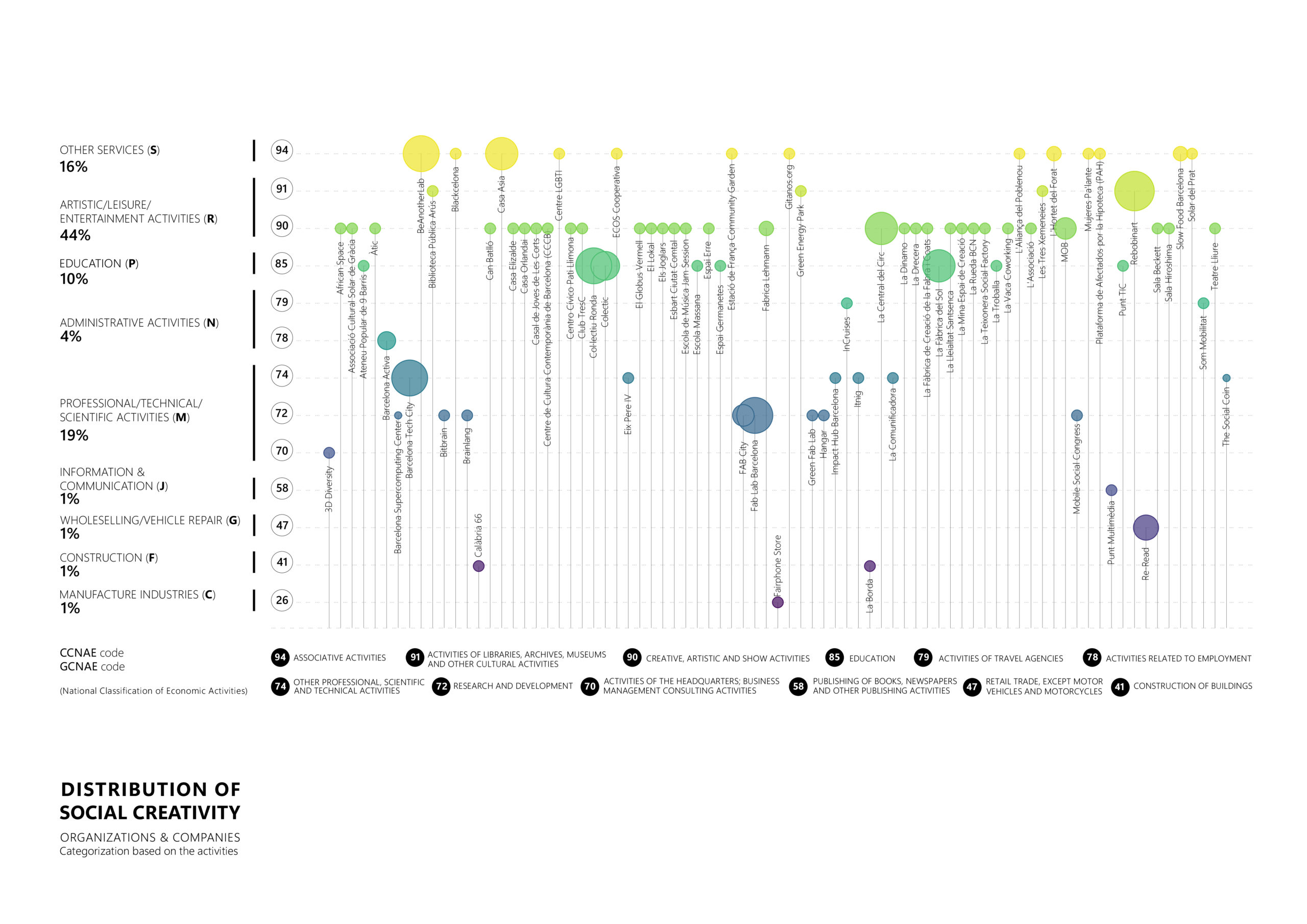
Stakeholder analysis is a critical tool for evaluating the role and influence of various factors in the creative industry. Our study analyzes the 126 stakeholders who support the 80 social organizations and companies in our sample. By categorizing the stakeholders into eight main groups: Companies, Foundations, Research and Educational Institutes, Organizations, Associations, Local and National Government and the European Union, is revealed that Associations and Foundations provide over 50% of the funding for the social creativity industry, while the Public Sector’s contribution accounts for only 36%. Among the stakeholders, Barcelona City Council and Fundació La Caixa have the highest level of involvement, followed by Fundació Banc Sabadell, Generalitat de Catalunya, and the European Commission.

Moreover, the project provides an interactive platform that serves as a hub for public administrations, supportive stakeholders, and creative individuals and organizations to explore the social creativity ecosystem. Through the platform, users can navigate information about active organizations, including their latest projects and contact information.
-Barcelona: The City of Marvelous Disorder-
– A city composed of movement, and change, where, as Jane Jacobs suggests, distinctive parts miraculously reinforce each other, and compose an orderly whole.
– A place full of new improvisations.
– A marvelous jungle, which following Richard Sennet and Pablo Sendra, is composed of a rich mix of classes, ethnicities, and cultures.
– A city where urban infrastructures are designed as flexible, adaptable and open.
– A disorder, understood not as a made one, but a grown order, that allows the individual expression, and the reflection of the character and dignity of the place.
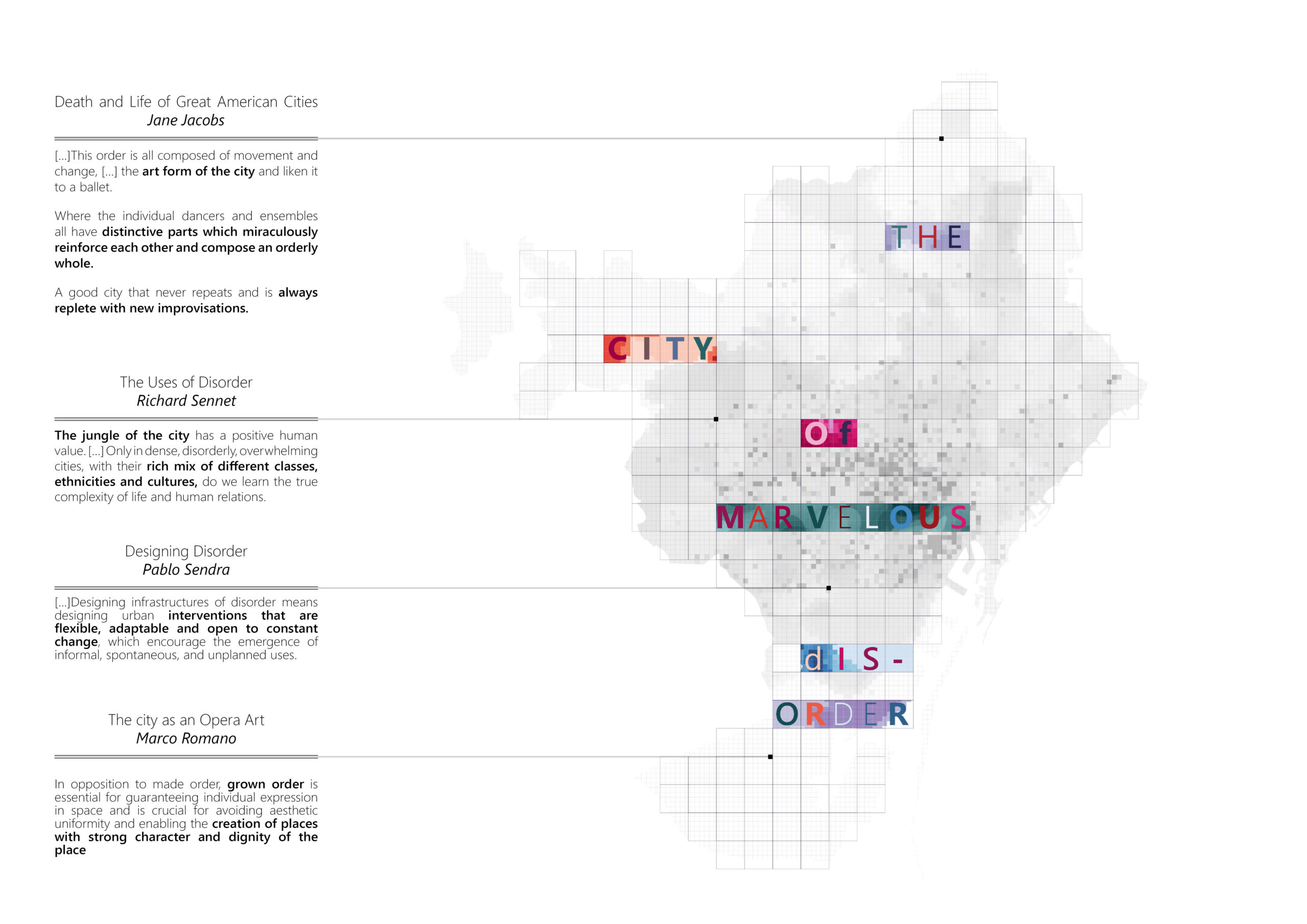
// FUTURE PROJECTIONS:
A spatial analysis was conducted to assess the state of the creative sector in Barcelona, which involved mapping out both organizations and companies and their respective projects. Using an algorithmic clustering approach, the entities were grouped together based on their proximity (within 250 meters), with a minimum requirement of at least two organizations/projects per cluster and the engaged stakeholders. The resulting catalog of match-making consists of 18 distinct clusters, each with their unique identities, activities, levels of interaction, and social impact.

How different agents could benefit from an ecosystem of proximity?
- Public administration: Optimizing Advise and Training resources, within ongoing programs such as Digital Fablab Network, or building on community engagement through localized urban interventions in the frame of the Citizens Lab or Pla de Barris.
- Supportive stakeholders: Providing more hands-on support and guidance, building a more diverse and richer portfolio of companies.
- Creative organizations: Enhancing collaboration with each other, sharing fresh ideas, trends, and knowledge as well as gaining public visibility among residents, through community events and workshops.

Is the social creative industry influenced and driven by particular socioeconomic and cultural factors?
Our demographic analysis aims to comprehend the intricacies of Barcelona’s different districts by selecting the most representative highest or lowest values of indicators such as nationality, educational level, income level, among others. However, by comparing this analysis with the chosen clusters, rises that the social creativity in contrast to the traditional cultural sector, does not adhere to strict spatial and demographic patterns on maps, likely due to its reliance on individuals.

As a potential continuation of the study, three distinct clusters are examined, exploring various aspects such as their size, the stakeholders involved and the demographic composition of their wider area are located in.
The first cluster (1) is situated in Sagrada Familia, an area known for its high-income residents and educated population and integrates elements of Asian and African cultures with immersive technology. A combination of food production with literature takes place in the second cluster (2) in Sant Pere, while the third one (3) that is located in Sant Antoni – an area characterized by high population density and low income level – combines activism-related performing arts with an emphasis on accessibility for individuals with disabilities.
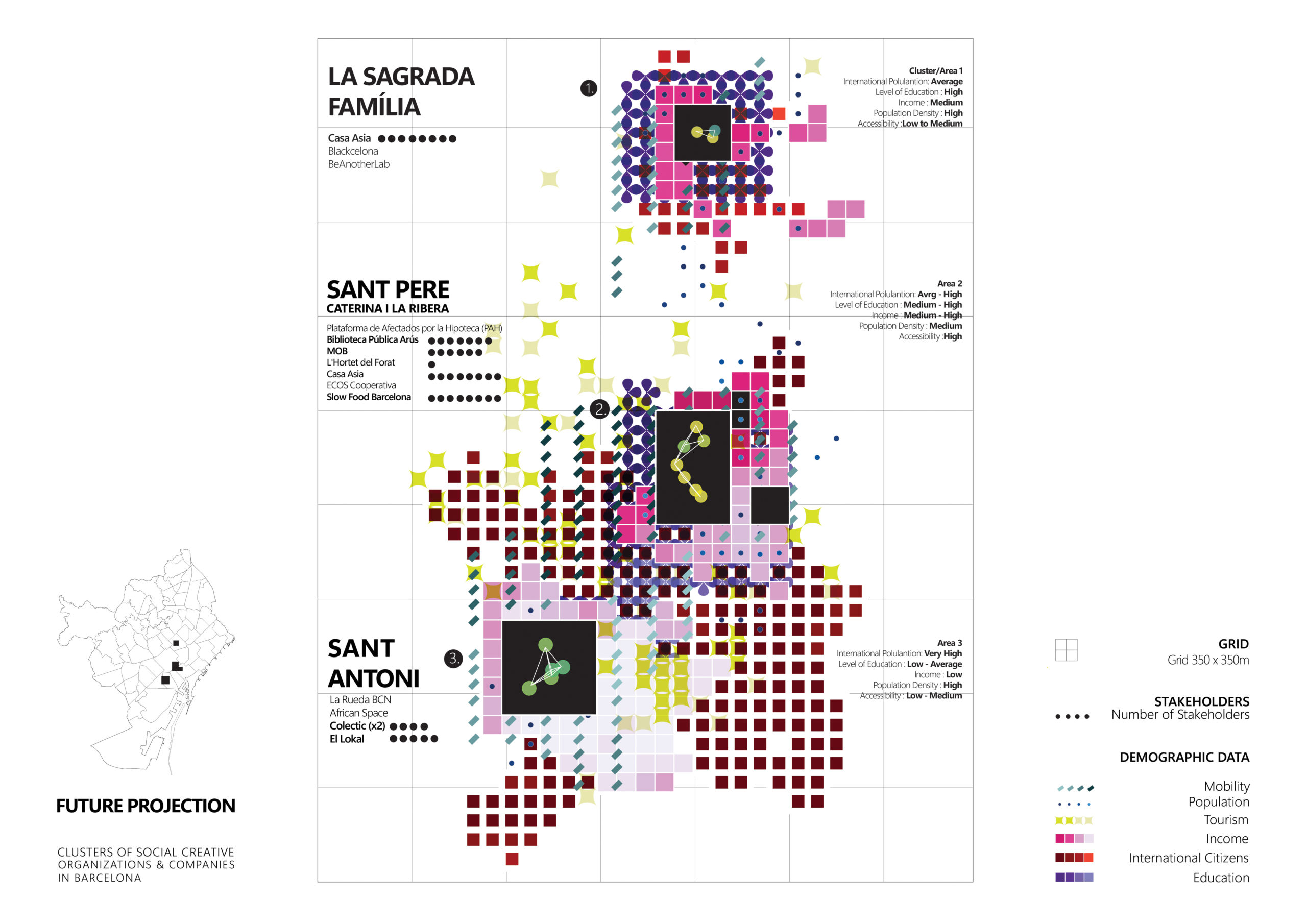
We cannot provide a predetermined outcome for the three collaborative projects, as the process should not be solely determined by us. Nonetheless, the matchmaking process has allowed us to identify the primary participants, their actions/behavior, and their potential to act collectively in those neighborhoods. As an illustration, one instance of the collaborative projects could involve a public art display featuring interactive soundscapes, while another could center around an event dedicated to food production and literature or an urban intervention geared towards promoting performing arts in public spaces.
Those are just a few examples out of many opportunities that could emerge by bringing the individual behavior of those organizations in the same conversation, with the hope to extract the unexpected nature of social creativity in favor of their own growth but also giving new interpretations of citizenship and public life based on permeable borders and improvisations.


